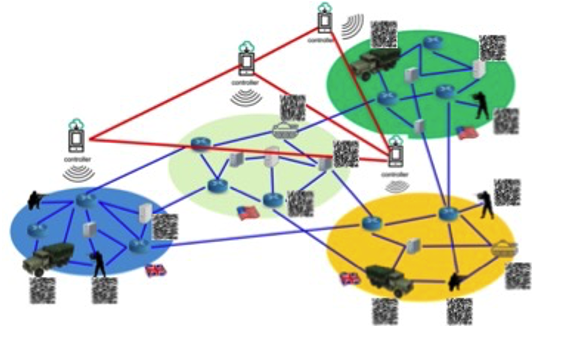Vector Symbolic Architectures and Hyper-dimensional Computing for Coalition Operations - An Overview
- Technical achievement: Watch the video
- Demonstration: Watch the video
Military / Coalition Issue
Future military coalition operations at the network edge will require multiple sensors, devices and services owned by different coalition partners to be dynamically combined into workflows that can perform new complex tasks on demand. The coalition challenge is one of interoperability. How do we describe sensors, devices, and services so that they can be discovered and interconnected to achieve this mission goals? To address this challenge, we have been investigation the possibility of using a mathematically precise representation of information, where the information is encoded in the form of symbolic vectors.
A Vector Symbolic Architecture (or VSA for short) is a biologically-inspired method for representing and manipulating concepts and their meanings. Symbolic vectors simultaneously represent a semantic description of a concept and because they are vectors, they also are a pointer to the concepts. Chris Eliasmith, in his book ‘How to Build a Brain’ shows how these vector representations can be used to perform `brain like’ neuromorphic cognitive processing. In our work we make use of large binary vectors with dimension typically in the range 1000 to 10,000 bits. We call such vectors ‘hypervectors’. The fundamental idea behind this work is that any type of information, including complex service descriptions and service workflow, can be constructed from component vectors using a process of hierarchical vector binding and bundling such that the resulting vector is the same size as the component vectors. We can think of these vectors as mathematical symbols of symbols (hence Vector Symbolic). These vectors/symbols can be exchanged to unambiguously convey information across coalitions but more importantly they can be used to perform decentralized command and control of distributed coalition assets.

The idea is illustrated here where the square symbols illustrate the symbolic hypervectors. Descriptions of sensors, services are converted into this symbolic representation and stored locally. The required configuration of these assets is constructed as a symbolic vector of vectors and injected into the communications network. Through a process of peer-to-peer vector exchange the required assets are discovered and linked together to perform the required task.
We have prepared a video presentation that explain VSA in more detail, and a video presentation that shows how decentralized workflow construction is executed in a representative TacCIS environment - (https://ibm.ent.box.com/v/Showcase-1a02-video). We also have a video presentation which explains how VSA can be used for unambiguous communication exchange in coalition operations, by using semantic symbolic vectors where coalition partners may use different terminology/language to describe the same assets.
Finally, we have been investigating how VSA operations can be performed in energy constrained environments using new emerging devices that can perform ‘In Memory’ and/or neuromorphic (i.e. spiking neural network) processing. Energy savings of the order of x100 are achievable in comparison to equivalent standard hardware implementations. Two video presentations giving further detail are available (https://ibm.ent.box.com/v/Showcase-1f01-video) and (https://ibm.ent.box.com/v/Showcase-1f02-video).
Organisations
Cardiff, IBM Research US, IBM Research Europe, Purdue, ARL and Dstl